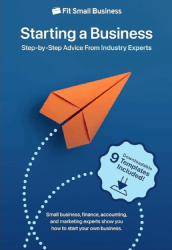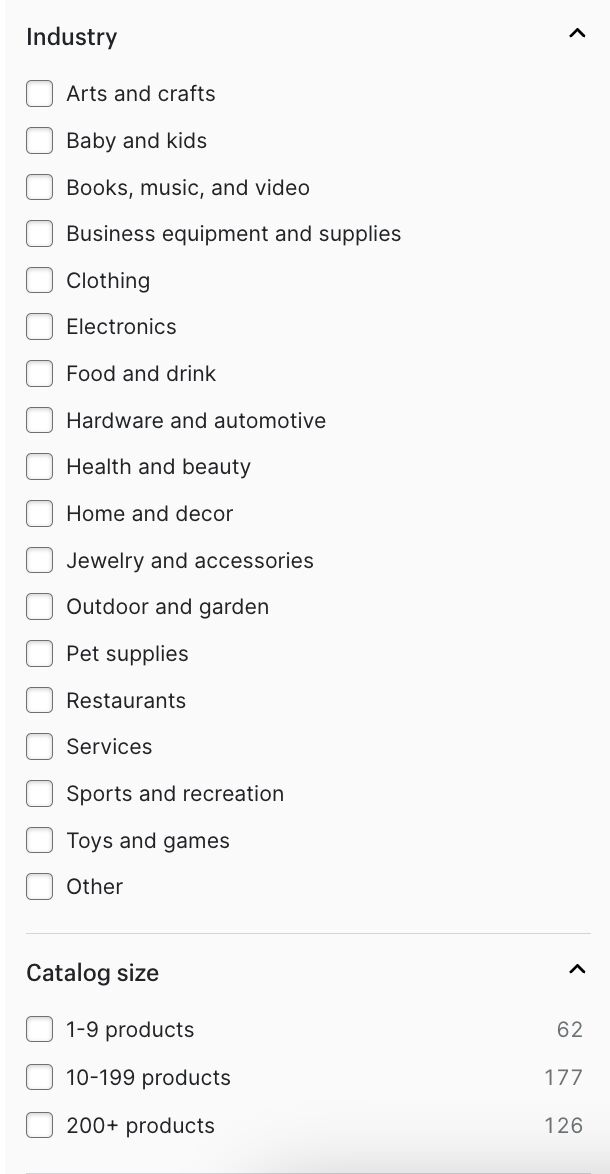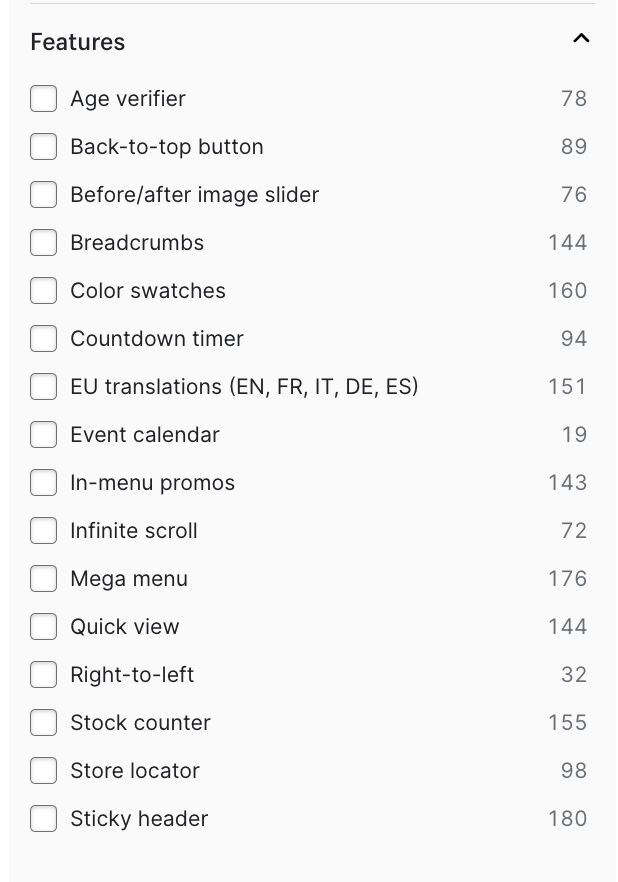Starting an online store involves choosing an ecommerce platform, building your website, setting up strong product pages, and integrating a payment provider. Overall, expect to spend around $300 in setting up an online store (excluding sourcing or manufacturing products).
With plug-and-play ecommerce platforms and web builders, learning how to start an online store has never been easier. Shopify is our top pick among the ecommerce platforms we have tested and reviewed. It offers a three-day free trial and charges $1 per month for three months so that you can fully explore all its bells and whistles. Sign up for the free trial, and follow our guide below.
How to Start an Online Store Video Tutorial
Resources from the video:
- Learn how to import products from China
- See our top ecommerce website design tips
- Read our in-depth guide on SEO for ecommerce websites
An online store is just one of the sales channels you can set up when you decide to sell online. Before you set up an ecommerce store, you need to perform market research, decide on the products you want to sell, identify your target market, and take care of all the branding and legal requirements in starting a business. Make sure to cover all your bases—read our guide on how to sell online.
Step 1: Choose an Ecommerce Platform
The first and most crucial aspect of creating an online store is choosing an ecommerce platform. It is more than a website builder; it serves as the control center of your online business—inventory, order management, fulfillment, product listings, and marketing are all done through its dashboard.
There are several popular ecommerce platforms that many small businesses use to learn how to set up an online store.
Best Ecommerce Platforms & Online Store Builders Compared
Ecommerce Platform | Monthly Fee | Best For | Read More |
|---|---|---|---|
 | $39 |
| |
 | $39 |
| |
 | $0+ |
| |
 | $0+ |
| |
$36 |
| ||
 | $27 |
| |
Based on our evaluation of the best ecommerce platforms, the choice of an ecommerce solution for most small businesses usually comes down to BigCommerce vs Shopify.
Shopify is our top-recommended ecommerce platform for small businesses, whereas BigCommerce is better suited for larger-revenue businesses, especially those that have complex inventories or want to save on processing fees.
To see how Shopify compares with the rest of our top picks, read our comparison guides:
When to use a WordPress site: If your business is not a dedicated ecommerce site but rather a blog, coaching, or publishing site that also sells merchandise, you may also create a WordPress site and add a WooCommerce or other WordPress shopping cart plugin. Businesses can turn any existing WordPress site into an ecommerce store by using these plugins, so it is a good option for those looking to sell merchandise or expand into retail sales.
Our related resources:
Most ecommerce website builders offer mobile-first website templates, varying levels of inventory management tools, reporting, and options for connected payment processing.
We recommend looking for these key features when deciding on an ecommerce platform:
- Mobile-first website templates and drag-and-drop builders: Mobile commerce is expected to account for about 40% of US ecommerce sales by 2024, so it is imperative that your online store be mobile-first. Also, look for an ecommerce builder that features a drag-and-drop online store editor to help you easily create your online store.
- Ease of use: Go with ecommerce software that is easy to use and navigate, especially for tech newbies. Ecommerce website builders should be intuitive and quick to set up. Sign up for a free trial to help you decide which platform is a better fit for your business needs.
- Customer support: Most ecommerce platforms provide support, but it is helpful to go with a platform that offers support all, or most, of the time. For example, Shopify provides 24/7 support through live chat, email, and phone in 19 languages.
When setting up an online store, look for ecommerce platforms that offer native or plug-in solutions for selling and advertising on social media, selling in person, selling on third-party marketplaces like Amazon, and connecting a blog. These features help you easily scale and market your online store.
Also, consider your current and future needs. While some may be the best solution for today, it might be a wiser investment to go with a more powerful platform if you wish to have one that can support your future growth.
Don’t leave this out—you need to have a rough estimate of your startup costs. While building an online store generally costs around $300, starting a business and securing products will be another matter. For ecommerce businesses, startup costs during the first year of operations vary significantly depending on your inventory, staff, facilities, marketing, and fulfillment strategy.
Related: Ecommerce Website Cost: Complete Pricing Guide
Shopify research shows that new online store business owners can expect expenses to reach up to $40,000 in the first year, recoverable through profit margins (with a timeframe set up to 18 to 24 months).
Shopify found that general expense categories during the first year would look something like:
- Product sourcing and procurement (31.6%): Raw materials, manufacturing, patents, etc.
- Operating costs (11%): Legal and accounting fees, business insurance
- Online store costs (9%): Ecommerce platform subscription, web developer, etc.
- Shipping costs (8.7%): Packaging and labels
- Offline/Overhead costs (10.5%): Rent, equipment, etc.
- Employees/hiring costs (18.8%): Salaries, benefits, compensation
- Marketing costs (10.3%): Logo, branding, printed materials, business cards, etc.
If you need help with business funding, consider applying for startup business loans.
How to Estimate Startup Costs
Based on the estimated expenses above, categorize your spending allocations by the following:
- Essential vs Optional Expenses: When budgeting, classify expenses that are absolutely necessary (and even critical) to your business. This will boil down to priorities, but we recommend having a rigid standard when you are just starting out. For example, paid ads will likely help your business garner attention quickly, but you can get the same result in the same amount of time with a carefully planned marketing strategy.
- One-time vs Recurring Expenses: One-time expenses include patent filings and business formation documents. Recurring expenses are your operational or overhead expenses, like subscriptions and employee salaries. Keep an eye out for recurring expenses so that you can estimate how much you will be spending on them over your first year.
- Fixed vs Variable Cost: These are usually part of your recurring expenses. Your subscription fees are likely to stay fixed during the year, but utility bills can vary monthly.
It’s crucial to spend the first year of your online store’s operations tracking expenses, testing cash flow, sticking to set budgets, and reinvesting sales back into the business.
You can also download our ebook on how to start a business for detailed insights on budgeting and planning a new business.
Step 2: Build Your Ecommerce Website
After choosing a platform, build your online store’s website by selecting a theme, customizing your site, putting security measures in place, and getting any necessary add-ons. Use your brand design and custom products or packaging as a guide to choosing fonts, a color scheme, and an overall look.
Should you build a custom store?
Larger businesses with developers may benefit from a custom store. However, most small businesses that don’t have a developer and want to manage the website themselves would have the flexibility to do so with a templated design from one of our recommended ecommerce platforms. Remember, even if you start with a template or theme, you can still customize your online store to suit your needs and your brand.
Branding will play a big role in designing your ecommerce website. By this time, you should already have your brand identity—your branding kit and collaterals—completed. In a nutshell, your business should have:
- A logo
- Brand colors (color scheme)
- Font types (typography)
- Packaging designs
- Imagery (stock and lifestyle photos)
- A brand story, which helps define voice and tone for written copy
Use your brand colors and fonts on your website as much as possible—but do not go overboard. While it is nice to have prominent brand colors displayed on your homepage, it would not be as visually pleasing if all your anchor links showed up in your brand colors, too. Additionally, product pages should be clean, with your product photos taking the spotlight. Display your mission and vision statements, core values, and brand positioning statement on key website pages.
Our related resources:
- Best Sites for Logo Design (Paid & Free)
- How to Create a Brand Style Guide (+ Free Template)
- How to Choose Brand Colors (+ Examples)
- Guide to Brand Color Psychology (+ Examples)
- How to Write a Brand Story (+ Free Template)
- What a Favicon Is & How to Use It (+ Design Tips & Examples)
No matter what ecommerce platform you choose, all of them have many options for free and paid templates or themes,
usually with multiple variations available. There are also many free and paid WordPress ecommerce themes available for
different shopping cart plugins.

A collection of available website themes in Shopify (Source: Shopify)
When choosing a theme for your online store, remember to
- Invest in quality: Don’t shy away from paid themes; spring for the one you think is best. It’s
not impossible to change themes later, but it is easier to pick the right one from the start. - Opt for a mobile-responsive or mobile-first theme: Mobile browsing makes up a large portion of
online shopping, so ensure your theme is optimized for mobile. - Evaluate product pages: Quality product pages help increase conversions. Choose themes with
options for lots of high-quality photos and/or images, multiple types of product descriptions, and other dynamic
content. - Filter themes based on your business needs, size, product catalog, etc.: Some themes are better
suited for apparel because of their catalog presentation, while others are designed for restaurants and
service-based businesses because they provide booking forms and provisions for displaying menus and service
pricing. - Look for specific website features that are a priority for you: These include a search bar that
auto-completes queries and a section that displays user-generated content.
Most ecommerce platforms let you filter their themes by industry, catalog size, and features. Focus on these instead of website colors since you will be changing these to your brand colors. (Source: Shopify)
Store customization will greatly depend on your chosen platform, but most ecommerce platforms have drag-and-drop builders that allow you to easily customize your online store.
To learn how to set up an online store using different ecommerce platforms, see our guides below:
Follow ecommerce website design best practices, including:
- Prioritizing navigation features: Easy navigation is critical for a positive user experience, so ensure your site has great header, search, and related product navigation features. Don’t forget to add a sitemap to make your website easy for search engines to navigate.
- Displaying customer reviews: Have a way of collecting and displaying reviews and other user-generated content on your website from the get-go. This type of content helps build confidence and trust among potential customers.
- Making it easy for customers to contact you: Include a chat option, like Facebook Messenger, and a phone number with clear support hours. Add an FAQ section with store policies and common questions.
And don’t forget about the UX experience! Equally important is the experience of the website visitor in their shopping journey in your store. You can learn about improving your store’s UX experience through our ecommerce UX best practices.
When we reviewed some ecommerce platforms, we replicated the same store across each site builder for an apples-to-apples comparison. This is our demo store built on Ecwid’s Instant Site Builder.
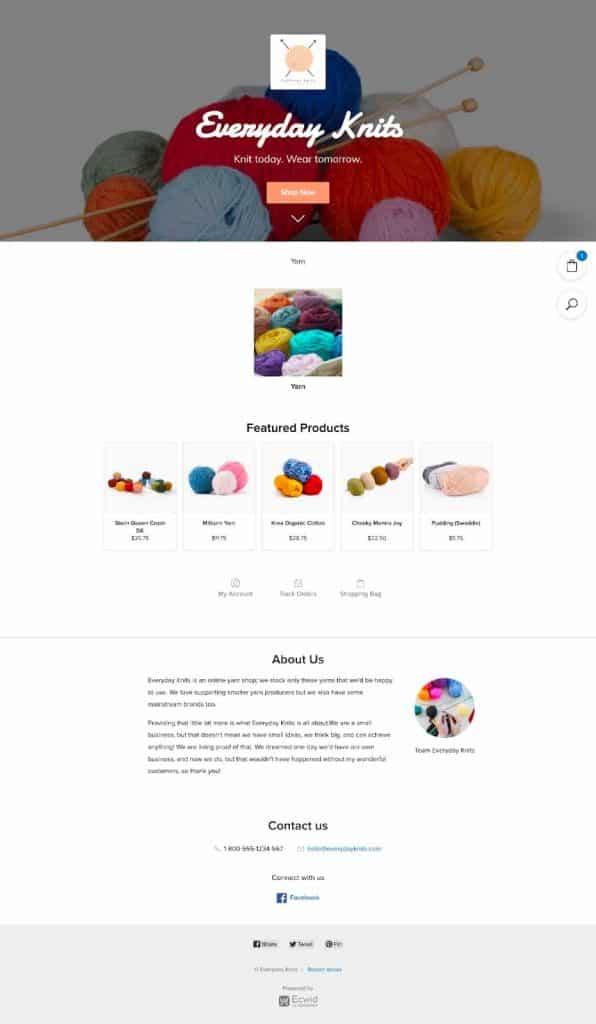
When we reviewed some ecommerce platforms, we replicated the same store across each site builder for an apples-to-apples comparison. This is our demo store built on Ecwid’s Instant Site Builder.
Step 3: Set Up Your Product Listings
When your online store infrastructure is in place, it’s time to add the actual products. There are multiple layers to this process. First, you’ll need to enter all the inventory data for each item—like wholesale price, retail markup, vendor information, SKUs and barcode information, categories, colors, sizes, quantities, and other data points relevant to your specific merchandise.
Our related resources:
- How to Make a Barcode + Free Barcode Generator
- What Is an SKU Number? A Complete Guide
- How to Price a Product + Profit Calculators
If you already have your initial inventory, you can upload this information in bulk via a CSV or Excel file. You can also use our free inventory templates to help you get started. Otherwise, you can manually enter each product.
After you enter the data, create a detailed individual product page for each item. For ecommerce websites, product pages are arguably the most important element of the site. Shoppers can land on a product page after browsing your store, from a Google search, or via a targeted advertisement.
A product page should have:
- High-quality photos: Product photos can make or break sales. Use high-quality images that show products from all angles, in all variants, and in action where situationally relevant.
- Customer reviews or social proof: When buying online, shoppers can’t see or feel the product for themselves, so they rely on customer reviews to assess product quality. Incorporate user reviews in product pages and/or photos and testimonials from social media—most ecommerce platforms have these features built-in or available through a plugin.
- Clear pricing information: Pricing should be displayed prominently and clearly indicate whether or not the price displayed is before or after any promotions.
- Easy “Add to Cart” buttons: Add a large “Add to Cart” button next to product images and below pricing information; the goal is to get shoppers to buy, so make sure the button is a color that stands out.
- Detailed product descriptions: Product descriptions should be concise and include precise product information like size and material, but should not be sales-y.
- Proactively addressed customer concerns: Indicate whether or not shipping is free or calculated at checkout, or if there is a minimum order for free shipping.
- Related products: At the bottom, display similar products or items people who bought the item also purchased—some ecommerce platforms have this built-in, while others have this feature available through plugins.
Write Well-crafted Product Descriptions
Product descriptions should be uniform across the site, following the same template and tone throughout. In general, there should be three elements to a product description: a short intro, bullet points outlining high-level features, and a longer description at the bottom for shoppers who want greater detail.
To write well-crafted product descriptions:
- Keep your target market in mind. Write in their language.
- Keep text easily scannable. Break copy up into short sentences and paragraphs, and make use of bullet points.
- Anticipate common questions. Also, ensure you can address them in the description.
- Make it easy for customers to see themselves using the product. Since they cannot physically touch or try the product, include materials used, size charts, and anything that can help them imagine how it looks when tried on.
We have an in-depth article on how to write product descriptions that convert if you need guidance.
Upload High-quality Product Photos
Product photos are one of the most important elements of an online store. High-quality images can showcase the details and quality of an item, while low-quality or grainy photos leave shoppers with more questions than answers.
Some wholesale suppliers will provide high-quality photos of their products, which will save you a lot of time and money. Ask your suppliers if this is something they provide. If not, you can either take the photos yourself or hire a professional.
When taking the photos yourself, use a plain white background in a well-lit area. You can do product photography on a budget with a smartphone camera and natural light. Though, if you are not a professional or experienced photographer, for the best (and fastest) results, there are services that specialize in ecommerce photography.
Download our e-book on product photography to learn how to take professional-level photos at home. We show you how to build a DIY photo studio and take different types of product photography shots.
In addition to standalone product shots and 360-degree photos, consider photos of the product in use. This is especially important for apparel, accessories, and makeup. Shoppers will want an idea of what the product will look like when worn. For decor and house items, consider lifestyle photos of the products so that customers can picture the items in their homes.
Set Clear Pricing
Several factors affect your products’ prices, and these include raw materials, overhead expenses, and shipping costs. The perceived quality of your product and demand for it also greatly impact how you can price it.
Remember, you can adjust prices based on what happens after your product launch. Read our pricing strategies, which come with examples, to learn how to competitively price your products.
Ensure that when you set the price on your product page, it is clear and there are no hidden fees that might surprise the customer during checkout—this can lead to cart abandonment. Having set shipping options or even a range (which we discuss in detail in Step 5) contributes to transparency.
Organize Your Products
Your ecommerce platform comes with built-in features to organize your products. We recommend that you utilize these to organize your catalog, especially if you have an extensive product line.
You can organize your products by:
- Product type (shirt, pants, scarves, socks, etc.)
- Supplier vendor (your manufacturer, wholesaler, or third-party vendor for the product—this helps easily reorder inventory)
- Keywords or tags (this helps customers search by keyword, product type, or format—anything you’ve set that helps organize your products).
- Category or collection (Best sellers, on sale, limited edition, or by season—this can be a curation of your products for specific purposes and audiences)
Optimize for Search Engine Results
Part of setting up your products for success is to optimize them for search engines. Setting details—such as a good product title, a short description, and a URL that contains your product name—go a long way in helping your products show up in search results.
In Shopify, you can easily set these inside a product page, as shown below:
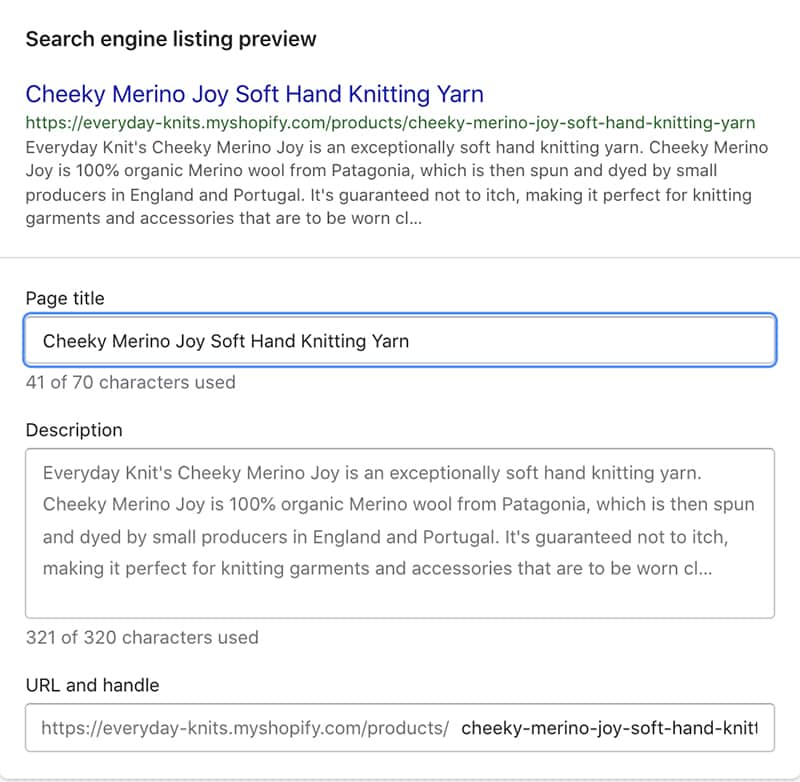
You can also manipulate the meta information that Google and other search engines display on results pages.
Here is what a product page usually looks like in a search result in Google. As you can see, consumers see your store’s name, logo, and product URL, as well as the product’s name, description, and price (plus whether it’s available!).

Step 4: Integrate Payment Processing
Integrating payment processing is a mundane yet critical element of building an ecommerce website. As an online retailer, you’ll need to choose a Payment Card Industry (PCI)-compliant payment processor. Many ecommerce platforms have built-in payment processors or a few select payment partners that are compatible. Any built-in payment processors will be PCI-compliant, e.g., Square, Shopify Payments, Stripe, and PayPal.
Choose a Payment Processor
For most small businesses, opting for a built-in payment processor is the easiest option. Payment processing rates across ecommerce platforms are usually competitive. For example, Shopify has its built-in payment processor called Shopify Payments, while Square Online works with Square Payments.
However, once you start to grow larger (processing more than $15,000 per month), it may be worthwhile to actively shop for a payment processor that can offer lower rates or negotiate a lower rate with your existing processor as you could qualify for volume discounts. BigCommerce is a popular choice for large-volume sales-based businesses because it doesn’t charge transaction fees when you go with a different provider.
Credit card processing fees are a necessary cost of doing business. Learning about credit card processing and transaction fees will help you find the cheapest credit card processing companies that will work well for your business.
Add Alternative Payment Methods
As an online seller, it’s critical to have an option for shoppers to enter their credit or debit card information. However, having more user-friendly options like one-click and e-wallet payments, PayPal, and installment options (buy now, pay later) are important for increasing conversions and sales.
Most major ecommerce platforms have a direct integration for accepting PayPal payments, and many also accept NFC payments, such as Apple and Google e-wallet payments.
For example, Shopify provides stores with a feature called Shop Pay (formerly Shopify Pay), a customer-facing checkout that saves a buyer’s details. This allows shoppers to purchase items quickly just by clicking the Buy Now button. It’s exclusive to Shopify stores, but it works across every Shopify store that uses Shop Pay.
Our related resources:
- Shopify Payments review
- Square Payments review
- Pros and Cons of PayPal: Guide for Small Business
- What Is an NFC Payment & How Does It Work?
- What Is BNPL? A Small Business Guide to Buy Now, Pay Later
- How to Offer Customer Financing
- Best BNPL Apps for Small Businesses
Optimize Checkout Pages
One of the biggest reasons for cart abandonment is a complicated checkout process—shoppers said that when it is too hard to navigate, lacks security seals, or asks for too much information, they abandon their carts.
So, simplify your checkout process by asking for essential information, offering a guest or express checkout (or a one-click checkout, if available), extending a variety of payment methods, displaying areas for applying gift cards and discounts, and providing a clear link to your policies on shipping and returns.
Payment security is still a big concern for most online shoppers, with 57% of online shoppers still wary of using mobile apps to make purchases. Read our guide to learn how to implement ecommerce payment security.
Our related resources:
- Shopping Cart Abandonment Statistics to Know
- What Is One-click Checkout & How Does It Work?
- Ecommerce Payment Security: Small Business Best Practices
- How to Write a Retail Return Policy (& Free Templates)
- Checkout Optimization Tips for Small Businesses
Configure Sales Tax
Sales tax works differently for online businesses, as you’re operating in multiple states. Luckily, most ecommerce platforms, including Shopify and BigCommerce, automatically calculate sales tax at checkout.
See our guide to ecommerce sales tax for more information.
Step 5: Configure Backend Operations
Once you are done setting up your product listings, it’s time to configure your logistics in the back end—managing inventory, fulfillment, and shipping.
Part of efficient order fulfillment is having an effective inventory system. Inventory management is the process of ordering, tracking, and storing your products to meet demand efficiently. It’s a crucial part of any retail or ecommerce business.
Tracking inventory stock effectively helps businesses prevent stockouts (minimize carrying costs and shrinkage), manage multiple locations, and ensure accurate recordkeeping. An inventory solution makes these processes easier than trying to do them all manually.
There are paid inventory solutions and specialized systems, such as POS inventory software for those managing a storefront or doing in-person sales. However, there are also free inventory management tools and inventory templates to help you get started.
If you need more help establishing a full process, read our guides to retail inventory management, stock-keeping unit (SKU) vs universal product codes (UPC) numbers, and SKU generation for products.
Our related resources:
- How to Organize Inventory for Small Businesses
- Best POS Inventory Systems
- Best Inventory Management Software for SMBs
- Safety Stock Definition & Calculator
- What Is the FIFO Inventory Method? First-In, First-Out Explained
Processing, picking, and packing customer orders are part of the order fulfillment process. When starting, many small businesses handle this process themselves out of a garage or storage space. However, some companies handle order fulfillment for ecommerce sellers.
There are four different ways to do this: in-house fulfillment, outsourced third-party fulfillment, dropshipping, or a hybrid approach.
In-house Order Fulfillment
In-house order fulfillment is literally in-house—all your customer orders are processed, picked, packed, and shipped under your roof. Your business handles all phases of the order fulfillment process, including receiving and storing inventory. This type of order fulfillment works best for businesses with full-time store owners or those that process fewer than 10 orders daily (usually startups or young businesses).
If you are fulfilling customer orders yourself, you have full control over choosing retail packaging materials and packing them in custom boxes. We also have a guide that features some eye-catching business packaging ideas that can help.
Our related resources:
Third-party Order Fulfillment
If you want to outsource order fulfillment, order fulfillment companies and third-party logistics (3PL) providers will store your products and then pack and send orders as they come in. With this fulfillment method, ecommerce businesses still purchase inventory upfront and send it to the order fulfillment company to store. This method is often ideal for ecommerce businesses that have outgrown their at-home fulfillment space and do not want to start their own warehouse and large-scale fulfillment operation.
Our related resources:
Dropshipping
Dropshipping companies serve as the product suppliers and fulfill customer orders, so ecommerce businesses don’t have to purchase upfront inventory. When working with dropshipping companies, ecommerce sellers are limited in that they can only sell products the dropshipper has available. However, there are fewer upfront costs and a lot less work involved for ecommerce businesses.
Shopify, our top-recommended ecommerce platform, connects with hundreds of dropshippers (such as DSers) through its Shopify App Marketplace. Learn how to open a Shopify dropshipping store.
Our related resources:
Hybrid Fulfillment Solution
A hybrid fulfillment approach combines some (or all) of the above order fulfillment methods. This is a popular solution for growing businesses because it offers a lot of flexibility. It is also ideal for brick-and-mortar stores expanding into online sales by allowing shoppers to buy online and pick up purchases in-store.
If you are packing and shipping customer orders in-house, choose a shipping software or service, look for cheap shipping supplies, and shop around for the most efficient shipping rates among FedEx vs UPS vs USPS—the most popular shipping platforms.
However, if you plan to ship internationally, there are different ways to do so, such as cross-border international shipping and localized fulfillment.
Choose a shipping strategy that will work with your business needs. Some of these strategies include:
- Offer free shipping. You can use this as an incentive for customers. You can tie this offer with a minimum required spend, to certain product purchases, or specific regions.
- Charge real-time carrier rates. Many ecommerce platforms have built-in integrations with USPS to generate real-time pricing on shipments.
- Charge a flat rate on shopping. This strategy is ideal if your product line has similar weights and sizes. This makes actual shipping costs easier to predict.
Check out our guide to ecommerce shipping and handling (with free SOP checklists). If you have a brick-and-mortar, you can ship from store.
Explore all the ways to save on shipping costs—the cost of shipping is a top concern for 41% of retailers:
- Cheapest Way to Ship a Package: Tips & Shipping Options
- Zone Skipping: A Money-saving Shipping Strategy
- What Is ePacket: Delivery, Shipping & Tracking
Popular ecommerce platforms like Shopify, BigCommerce, and Square Online have built-in shipping tools. They have discounted shipping rates, automatically calculate shipping costs for customers at checkout, and make it easy for ecommerce businesses to print shipping labels directly from the order management system.
However, if you build your own site or use a shopping cart plugin that does not have these features, you’ll need to find a third-party solution. For small operations, Stamps.com is a popular option. It syncs with many online marketplaces like Amazon and Etsy, plus shopping carts like Magento. Simply import customer orders and print out the shipping labels at home.
Step 6: Get Your Store Ready for Launch
You’ve done all the big tasks—you just need to get your store ready for launch! There are a few steps needed to ensure your online shop is ready to accept customers. These include:
- Connecting your custom domain
- Installing or integrating into other sales channels
Think of a custom domain as your website address. When choosing a domain name for your online store, be sure to:
- Choose an extension (e.g., .biz, .us, and .net) that best reflects your store; .com is the most common
- Make it easy to spell
- Keep it as short as possible
Having your own website address builds credibility for your online store. It will look professional and help instill trust in your customers. Ecommerce platforms make this process easy, you just need to register your domain first.
Our related resources:
- Business Domain Name: A Quick Overview
- How to Register a Business Domain Name
- How to Choose a Domain Name (Dos & Don’ts)
We recommend adding sales channels on top of your online store—but they need to be relevant and worth the addition. For example, is the sales channel a place where your target customers are? Is the sales channel a part of your overall business goals and marketing strategies?
Remember, you don’t need to be all over the place—just a few key places where it’s worth investing your effort in. Here are some that are worth highlighting:
Marketplaces
Many successful ecommerce businesses grow by selling their products in more than one place. Even with a standalone store, many online businesses also sell on Amazon, Walmart, and Etsy. These platforms likely won’t drive traffic to your main store, but they are a good way to bring in revenue and can help strengthen your brand credibility and recognition.
Our related resources:
Social Media
For new online brands, advertising and selling on Instagram and Facebook are popular ways of gaining recognition. Both social platforms let businesses create advertisements that directly link to product pages or offer options to buy without even leaving the social site. TikTok is also the fastest-growing social platform today, reaching 1 billion users. It also opened its doors to online stores by providing built-in integrations with most ecommerce platforms.
Our related resources:
Step 7: Launch & Market Your Online Store
Once your online store is live, it will require a multipronged marketing approach with search engine optimization (SEO), email marketing to bring in returning shoppers, and social media marketing. Some ecommerce businesses also use in-person sales at pop-ups and events to grow their ecommerce businesses.
Our related resources:
- Ecommerce Marketing Strategy Ideas for Retailers
- Ultimate Guide to Email Marketing for Retailers
- How to Create a TikTok Marketing Strategy (+ Examples)
- TikTok Ecommerce Strategy Guide
- Retail Metrics: How to Drive Sales in Your Small Business
Create an SEO Strategy
Online stores need at least a basic SEO strategy to make sure that product pages appear in search results. To do this, ecommerce sellers need to target a keyword with each individual product page (such as “striped polyester t-shirt.”) Ecommerce websites should also make sure to add product titles and descriptions that will appear in search engine results and alt text for images.
Online store builders like Shopify and BigCommerce have built-in tools to set SEO up easily. In addition to optimizing individual pages, ecommerce sites should have a logical and user-friendly structure so that shoppers can easily navigate through them. For example, all BigCommerce websites include SEO features, such as an automated image optimizer, on-page SEO capabilities, sitemap generation, and site speed enhancers.
Grow Your Email List
Email promotions are one of the best tools an online store has for driving repeat sales and connecting with customers. Ask customers to provide their email addresses with orders, but also have a sign-up option for people who visit your site but do not make a purchase. Most ecommerce platforms have either built-in tools for email marketing or integrations with email marketing solutions like Mailchimp.
Market in Social Media
Social is the new search engine—a whopping 50% of shoppers do their research on social media. If you aren’t sold on social commerce (or selling on social) yet, create at least social channels for your brand. Include social media in your marketing plan, maintain consistent content posts, and engage with your followers.
Our related resources:
- How to Make a Social Media Plan [+ Free Template]
- Social Media Marketing for Small Business: Guide + Template
- Best Social Media Marketing Tools for Small Businesses
Starting an Online Retail Business Frequently Asked Questions (FAQs)
Click through the tabs below to get answers to your frequently asked questions about setting up an e-store.
Expect to spend around $300 in setting up an online store (not including the cost of your products). These expenses mostly come from paying for your ecommerce platform and marketing efforts. If you’re hiring staff and renting a workspace, be sure to budget for that additionally—as well as registering your business and buying inventory to sell.
Square Online has a forever-free option that allows you to build a multipage online store. Once you gain traction, you can upgrade your plan for more advanced features. However, expect to put in a lot of work and time before your store becomes significantly profitable.
While there are no guarantees you’ll make any money, you may make a profit with the right resources. Whether you’re covering the costs of your monthly hosting or making a full-time income, any of it is possible given the time, talent, and resources. Your income depends on your niche, audience, and expenses.
Yes, you can start an online store for free using free ecommerce platforms like Square and Ecwid, although you’ll need to pay for inventory to sell. Consider starting a dropshipping business to sell goods online without paying for inventory.
You can get products for selling online by importing products from China, dropshipping, starting a private label brand, or manufacturing your own products.
You first need to decide on a business concept. Once that’s ironed out, you can decide where to source your products and how you will fulfill orders. Choosing an e-commerce platform and then building your online store comes next, together with making sure you can process online payments by choosing a payment gateway. Finally, you’ll need to develop strong product pages and a marketing plan.
Our top pick for the best ecommerce platforms is Shopify. It is an easy-to-use platform that gives you all the essential features you need. You can build a full website, use its built-in payment provider (no need to apply on another platform), sell products online (and on social channels like Facebook), and have marketing tools at your disposal—all within the Shopify dashboard.
Whether you’re starting a brick-and-mortar store or an online store, most states will require a business license. This is so that you can collect taxes from your customers and the Internal Revenue Service can track tax revenue. Your state’s department of revenue should have the info you need.
Bottom Line
Statistics show that more than 55% of consumers prefer online shopping. It is clear that ecommerce is here to stay, and having an online store should be part of a retail business’ growth plan.
Shopify makes it easy for individuals or businesses of any size to start an online store. Preset templates and built-in inventory and order management features make it simple to get an ecommerce business up and running in no time. With several plans, individuals can start a small online store and grow it to an ecommerce enterprise. Visit Shopify today for a three-day free trial and to unlock a $1 per month price for three months.
